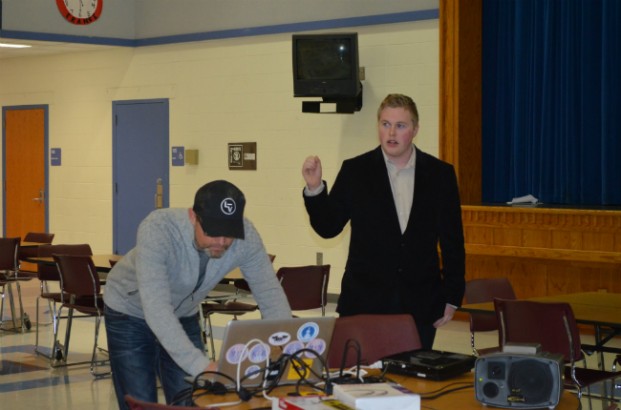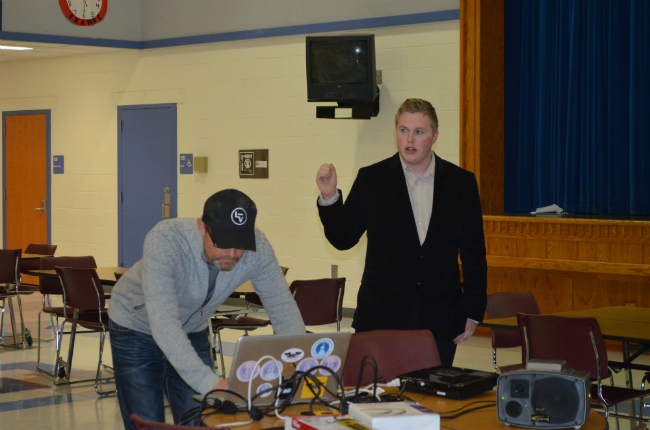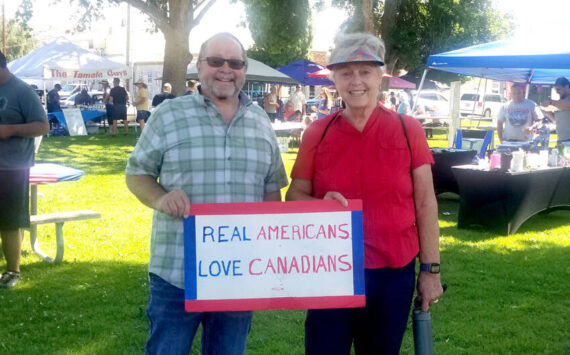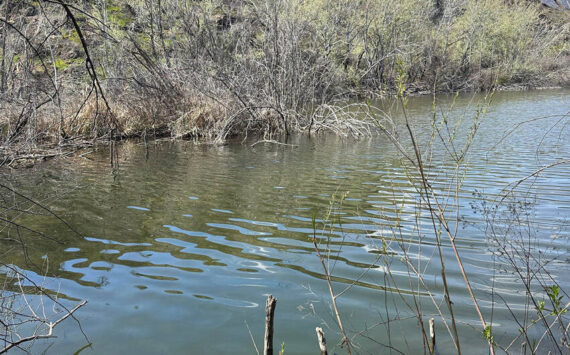
TONASKET – A preview showing of “Governed vs Governing: the Bundy Standoff,” held at Tonasket High School Dec. 16 and hosted by Mark Herr, gave audience members lots to think about over the holidays and beyond.
The first of a three-part series directed by local filmmaker Jeremiah Lofthus, the video documents events of the April 12, 2014 standoff in Nevada between the federal government and rancher Cliven Bundy, along with area ranchers and supporters of Bundy. The dispute began over Bundy’s refusal to purchase grazing permits after water rights inherited or purchased from homesteading and used by cattle and wildlife for the past century, began to be taken away.
Herr, President of the Center for Self Governance (CSG), an organization whose mission is to teach applied civics across the country, said he “accidentally” got the footage of the event when a class he was teaching in Arizona got cancelled. Herr said he took a student up on an invitation to attend the stand-off, something he knew nothing about at the time.
Herr filmed the entire event, to tell the story from his perspective as an observer.
“This film is not meant for the rancher, but to communicate to 99 percent of the people who do not own a cow or land. This is not about cows and grazing rights. This is bigger than that,” said Herr. “Most people on the east coast are not aware of the takeover that’s going on, or the strategies and tactics applied to force you out of rural areas and into cities.”
“Seeing the video footage really opened my eyes to what is going on across the country,” said Lofthus, who earned a BA in digital film and an MA in strategic communication. “I was really interested in this project because I think these stories should be told, in order to help people understand just how our government is set up to work. I feel that if we lose the knowledge of the freedoms that we have in this country, we can easily lose those freedoms entirely.”
Lofthus said the documentaries are not aimed at starting a revolution.
“We want to maintain the system we have, not change it,” said Lofthus. “It’s a good system. The revolution was the end all, and there are many things that can be done before that. In many ways, America has already won. The victory was won for our freedom, and we don’t want to lose that.”
Herr said when he was at the standoff, he was surprised to hear Bundy announce, “Now are we going to go and take our land back and declare freedom.”
Herr said when he asked, “How are you going to do that? You are not well armed. How are you going to accomplish that?” Bundy responded, “We are going to go up there above the freeway.”
The documentary includes public domain footage, as well as video shot by other individuals, with footage shot from the highway overpass of what Herr described as “a militarized force aiming arms at an unarmed public.”
Bureau of Land Management (BLM) agents aiming weapons are shown, along with snipers aiming at the public from on top of a plateau.
Herr said when Sheriff Tom Roberts negotiated a peaceful solution with the BLM agreeing to return the cattle, and commanded the BLM to regress and “back away from the protesters,” his own reaction was, “The BLM regress? That’s nuts; that’s never happened in U.S. history.’”
The Las Vegas Municipal Police Department commanded the BLM to leave, “out of concern for public safety and the BLM’s heavy-handed approach.”
“I saw for the first time in my life the federal agents backing up,” said Herr. Ryan Bundy is shown declaring “the west has now been won.”
“We are going to go in and open the gates and bring the cattle in. The lawful jurisdiction of authority has been restored here,” said Bundy. “We are all going to remain peaceful, there have been no shots fired.”
Herr said he counted 180 vehicles full of law enforcement leaving the camp.
“When the cattle were coming through, no one was screaming; everyone was being peaceful. It was such a contrast from the armed standoff when all you could hear was megaphones, and now all you can hear are the cows moving and everyone watching,” said Herr, who next caught a ride to the Bundy ranch, where he continued filming.
The preview at THS was attended by not just locals, but also online by several people across the U.S.; including Scott Drexler, who served 18 months in prison after attending the 2014 event in support of Bundy.
In a discussion following the preview, Herr pointed out, “These people were willing to die over someone’s else’s cows, so this was bigger than that.”
“This was not about the cows. This was about the overreach of the federal government,” said Drexler, who attended the event from Idaho “because of the First Amendment.”
Drexler estimated between 300-400 people were there in support of Bundy.
Drexler was arrested almost two years after the event along with 18 other defendants and charged with 10 counts in federal court. All but two of the charges were dropped, with Drexler serving 18 months in prison before taking a plea bargain “for time served and a little probation, versus the 120 years I was facing when I was first arrested.”
“I felt you did a really good job of covering what happened,” Drexler said in response to Lofthus asking what he thought of the film. Asked about reactions to the event from people in prison as well as in the general population, Drexler said it’s been very positive.
“I have people that approach me on the street, they come up and say ‘thank you.’ They say, ‘What you guys did is what we would all like to do,’” said Drexler. “If they’re not a government employee, their response is positive.”
When asked if he would do the same if he knew then what he knows now, Drexler responded, “Well, I would do it again. I may not go to the lengths that I did, but to be scared off from trying to stand for our republic and for the constitution really isn’t an option.”
“We want people to know not only these events, but the system,” said Lofthus. “The system the Founding Fathers laid out. If you don’t know it, you can lose it. We want people to understand the freedoms they have, as well as the responsibilities they have, and you have to balance both. There are multiple layers of government, and it’s designed that way to protect us from abuse. No one group has an unlimited amount of power, and because of that people in the United States have flourished. But just a little bit of ignorance is enough rope to hang you if you are not careful.”
A kickstarter campaign begun Dec. 16 to fund Part Two raised $4,000 in the first four days, and met a goal of raising $12,000 in a couple of weeks. Fundraising efforts continue, as the CSG is working to get the series onto video on demand and DVD BlueRay; and eventually into theaters, a very expensive process.
Herr and Lofthus spent three days in Burns, Ore., where they interviewed people for Part Two of the series. Called “Dead Man Talking,” it is a bio documentary on the life and death of LaVoy Finicum, the rancher shot during the 2016 occupation of the Malheur Wildlife Reserve in Oregon. A stillshot from a video shows Finicum being shot three times in the back, while holding his arms in the air, away from his body.
“Everyone who went to court in 2016 was acquitted,” said Herr, “except for LaVoy, who never got his day in court. Let the dead man tell his story.”
Part One includes an interview with Jeanette Finicum, LaVoy’s widow.
“Everything you have heard thus far is not the truth,” said Finicum. “LaVoy’s mission was to educate and to teach, and we have partnered with the Center for Self Governance. If you want to know the real story….come with me on this journey.”
“Filmmaking is the new printing press,” said Herr. “It’s a way to get out your story when the other avenues are not telling the truth.”
Drexler, who was not at the Malheur Wildlife Reserve occupation, but was in Burns at the time of the shooting, said watching the end of Part One was “the hardest part.”
“I was crying and standing there in the snow, and looking at LaVoy’s blood after they murdered him was very hard. But I knew he knew what could happen, and he was willing to die for the cause. LaVoy said his biggest fear was that when everyone showed up there and he was afraid they were just going to poke fingers at the sky and nothing would be accomplished,” said Drexler. “We’ve lit that grass fire and it is spreading. People are beginning to realize we can stand up against this corruption, and we can win.”
“This is more than making a movie, we are making a movement,” said Herr, who traveled to Idaho to interview Drexler in person over the New Years holiday, along with state representatives.
Herr said Part Three of the series will cover the final verdict about the court trials going on right now.
Last week (Dec. 20), U.S. District Chief Judge Gloria Navarro declared a mistrial over “willful failure to disclose information to the defense” in the prosecution of Bundy and his sons Ammon and Ryan, along with Ryan Payne of Montana, charged with 15 felony counts from the 2014 standoff. Attorney General Jeff Sessions has ordered a third-party examination of the case, and Navarro set a Jan. 8 hearing on defense motions to dismiss the case. According to the Washington Times, Navarro said key evidence prosecutors willfully failed to disclose include FBI records about surveillance and government snipers at the Bundy ranch; law enforcement threat assessments showing the Bundy family posed no threat of violence; and internal reports of BLM agent misconduct.
The government lost a key witness in their case when Daniel Love, the BLM agent in charge of the Bundy operation, was fired after a federal investigation found he misappropriated rare minerals and told a subordinate to conceal the misconduct.
At the preview, Herr and his wife, CSG Executive Director Pam Leslie, distributed copies of a novel written by LaVoy Finicum, with all proceeds going to his widow. Called “Only by Blood and Suffering: Regaining Lost Freedom” and published post-mortem by Jeanette Finicum in 2017, the book details LaVoy’s beliefs in property rights and liberty along with his belief, as outlined on his website onecowboystandsforfreedom, that “There are powers that be that seek to overthrow the freedom of mankind.”
Herr described his civics courses taught through CSG as “a training program for people to understand their government and how it has been changed.” Courses taught nationwide include a sequence in self-governance along with a variety of classes on state constitutions, regional government and county/city government. For more information, visit centerforselfgovernance.com.





